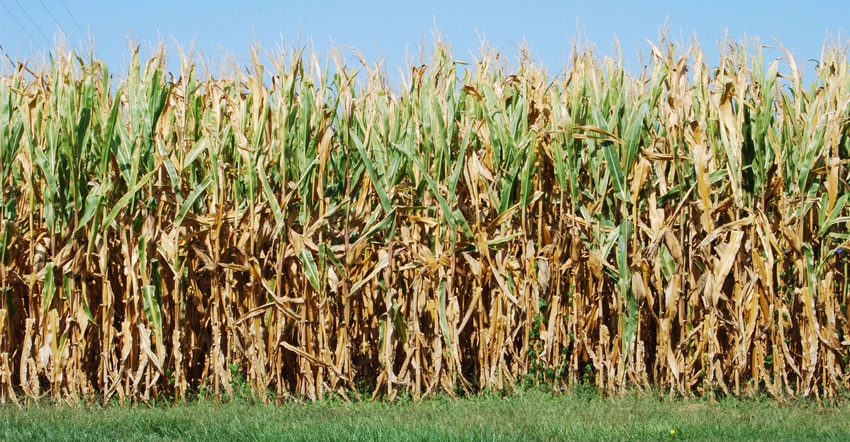
Entering September, Iowa’s corn and soybean crops continue to move toward maturity, with harvest now just a few weeks away. Some farmers are aerially seeding cover crops. Seed corn harvest is also getting underway.
USDA’s latest weekly survey, conducted as of Sept. 3, indicates 60% of Iowa’s 2017 corn crop has now reached dent stage, eight days behind last year and three days behind average. It shows 18% of the state’s soybeans have started to turn color, five days behind last year and three days behind average.
Iowa’s corn crop is rated 62% good to excellent, and the state’s soybeans are 61% good to excellent. Nationally, USDA rates the 2017 U.S. corn crop at 61% good to excellent, compared to 62% a week ago. A year ago, 74% of the nation’s corn crop was good to excellent. USDA says the U.S. soybean crop is now 61% good to excellent, the same as a week ago.
Summary of Iowa crop conditions
The complete weekly crop and weather report is available on the Iowa Department of Agriculture and Land Stewardship’s website and on USDA’s site. The report summary follows here:
It was a cool dry week in Iowa, the seven days ending Sept. 3, according to USDA’s National Ag Statistics Service. Statewide, there were 6.2 days suitable for fieldwork. Activities for the week included haying, hauling grain, chopping corn silage, seeding cover crops and harvesting seed corn.
Corn condition 62% good to excellent
Topsoil moisture for Iowa is rated 13% very short, 27% short, 59% adequate and 1% surplus. According to the Aug. 29 U.S. Drought Monitor, areas of south-central and southeast Iowa have been in a severe drought for five consecutive weeks. Statewide, subsoil moisture as of Sept. 3 is rated 17% very short, 31% short, 52% adequate and zero percent surplus.
The weekly survey shows 94% of Iowa’s 2017 corn crop in or beyond the dough stage as of Sept. 3. That’s five days behind last year but three days ahead of the five-year average. Also, 60% of the corn crop has reached the dent stage, eight days behind last year and three days behind average. Corn condition is 62% good to excellent.
Soybean crop 61% good to excellent
Eighteen percent of the state’s soybeans have started to turn color, five days behind last year and three days behind average. Soybean condition improved to 61% good to excellent. There were scattered reports last week of disease issues in soybeans such as sudden death syndrome.
The third cutting of alfalfa hay reached 91% complete, eight days ahead of last year and over two weeks ahead of average. Pasture condition rated 16% very poor, 23% poor, 35% fair, 24% good and 2% excellent. Cooler temperatures have been ideal for livestock; however, there were still reports of producers in south-central and southeast Iowa feeding hay to cattle due to poor pasture conditions.
Weather summary for Iowa
Harry Hillaker, state climatologist with the Iowa Department of Agriculture and Land Stewardship, provides the following summary for the week ended Sept. 3.
Last week was a dry and unseasonably cool week across Iowa. Temperatures were below normal throughout the week, except at a few western Iowa locations. Aug. 28 and Sept. 1 were the coolest days in most areas, with daytime highs in the 70s. Temperature extremes for the week ranged from Sept. 1 morning lows of 41 degrees F at Cresco and Elkader to a Sept. 2 afternoon high of 86 degrees at Albia. Temperatures for the week as a whole averaged from 4 to 7 degrees below normal over the east to slightly above normal in the far northwest, with a statewide average of 3 degrees subnormal.
Last week was Iowa’s driest since mid-June
Most of last week’s rain came on Aug. 27, when rain was scattered nearly statewide, with some very small areas of heavy rain in the Dubuque and Burlington areas. There were some thunderstorms on Monday over extreme eastern Iowa, with some localized heavy rains around Burlington. There were some isolated showers on Aug. 31, Sept. 1 and Sept. 2, but with rain totals mostly under 0.1 inch.
The town of Asbury in Dubuque County reported the most rain for the week, with 3.31 inches, while Burlington saw 2.72 inches. Much of central and south-central Iowa saw little, if any rain. The statewide average rainfall amount was 0.11 inch, while normal for the week is 0.88 inch. This was the state’s driest week in 12 weeks (mid-June).
Southeast Iowa has extremely dry summer
At Fairfield in southeast Iowa, the summer rainfall total (June-July-August) for 2017 was only 3.51 inches. This was their lowest summer rain total among 137 years of records at that location (old record 3.77 inches in 1911). The Ottumwa Airport recorded even less rain for the summer with 3.38 inches, but this amount ranked a distant second behind 1911’s 1.8-inch total at that location.
About the Author(s)
You May Also Like




